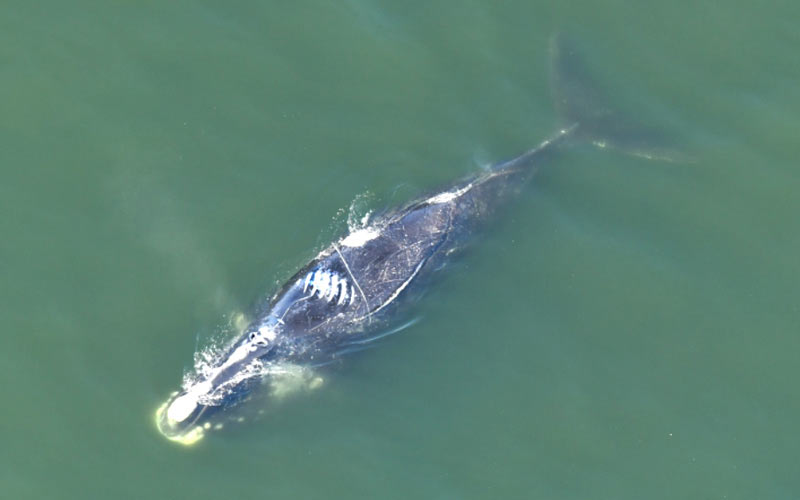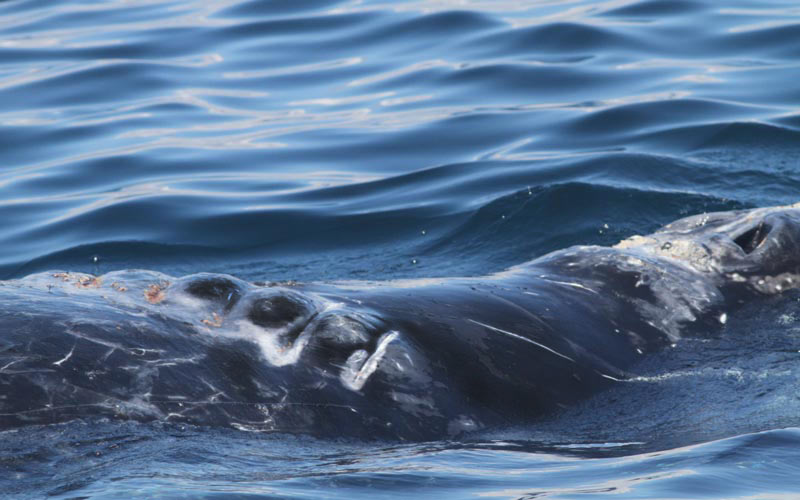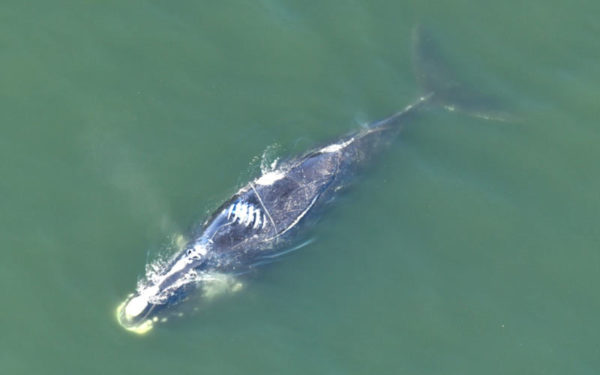
About half of north Atlantic right whales deaths are caused by vessel strikes. Even when whales survive, their lives and bodies are permanently scarred by propeller blades and traumatic collisions. Photo: North Atlantic Right Whale Consortium
Without immediate measures, the North Atlantic right whale population will continue to decline beyond the point of no return. Scientists estimate that little more than 350 whales are left on the planet – a shockingly low number. It is our activities in the ocean – fishing, shipping, drilling, construction – that threaten the survival of this species. In particular, collisions with marine vessels and entanglement in commercial fishing gears are the two most pressing threats to the whales’ recovery.
Though the situation is dire, we can still stop the whales’ extinction with urgent action. That’s why CLF is pursuing every angle to save these animals. Recently, we’ve stepped up our efforts to protect right whales from the threats posed by marine vessels.
Right whales are especially at risk of vessel strikes
In the last three years, vessel strikes have caused about half of the known or suspected deaths of right whales in the U.S. and Canada. Sadly, these magnificent creatures are particularly vulnerable to collisions because they regularly feed, rest, and socialize close to the ocean’s surface – even when those waters are regularly crisscrossed by heavy boat traffic. If even a small boat hits a whale, it could injure the vessel and people on board, but it’s the whale who suffers the most.
This year has been especially brutal. Two out of only 10 calves born in the 2020 season are already known to have been killed by ships. One was a newborn. The other bore scars revealing that, in its too-short life, it had previously survived one collision, only to succumb to its injuries from a subsequent crash.
And whales that do not die immediately from vessel strikes will often be left wounded and suffering.

Too Many Decades, Not Enough Protections
Right whales have been listed as “endangered” on the species list for over 50 years. However, decades of protections have not restored the population to sustainable levels. In fact, their number is declining fast. Since 2017, 31 right whales are known to have died, with another 11 presumed dead or suffering from life-threatening injuries.
That’s to say nothing of all the deaths and potentially lethal injuries that haven’t been observed. The actual number of deaths could be much higher, all at a time when even one dead whale is a tragedy for the struggling population. In fact, NOAA Fisheries just released a preliminary estimate that only 366 right whales were living as of January 2019. This is fewer than scientists expected, showing that the right whales’ situation is even worse than previously thought.
Even more concerning, barely a quarter of the remaining whales are known to be breeding females – making it much more difficult for this species under siege to survive.
We’re Fighting on All Fronts to Save this Iconic Species
CLF is working every channel we can to save New England’s whale from extinction. In the last two years, we’ve successfully litigated in federal court. Through these efforts, we have pushed the government to comply with the Endangered Species Act and the Marine Mammal Protection Act and to implement rules to protect right whales from deadly entanglement in commercial fishing gear. And for several years, we’ve worked with offshore wind companies to mitigate the impact of their projects on right whales and other marine mammals.
Now, we need to push the government to close the gap that leaves right whales vulnerable to injury and death from ships large and small.
Government Measures Can Effectively Reduce Right Whale Fatalities
Efforts by the federal government to reduce ship and boat collisions with North Atlantic right whales initially looked promising. First implemented in 2008, regulations restricted ship speeds to 10 nautical miles per hour or less for vessels over 65 feet in length that travel in certain areas (known as Seasonal Management Areas). The government also established a program that designated voluntary slow speed zones automatically and dynamically – in other words, in response to sightings of whales, mariners are asked to temporarily avoid an area or to travel through it only at slower speeds.
However, the spate of ship-strike deaths in recent years clearly shows the need for expanded and more stringent regulations to protect these creatures. Here’s why:
- While the Seasonal Management Areas do appear effective at reducing vessel strikes within their boundaries, the number of collisions outside of those areas has increased. This may be due in part to the fact that right whales are routinely turning up in different places than they were when the rules were first written, likely as a result of climate change impacting the distribution of their favorite food.
- Shorter boats – which do not trigger speed limits due to their size – have also caused many right whale injuries and deaths.
- Studies show that many mariners simply don’t comply with voluntary speed restrictions, making them ineffective.
The bottom line is that, while current speed regulations do help, too many right whales still get killed or seriously injured by boats. The government’s efforts to date, particularly in light of the many deaths over the last several years, have been inadequate. That’s why CLF and our allies are pushing for more.
We Are Asking the Government to Require More Restrictive Measures
Enough is enough – too many right whales’ lives continue to be lost needlessly to ship strikes. In August, CLF and our allies asked the government to act immediately to get more effective speed regulations on the water.
Based on the facts, we are urging the government to:
- Expand speed limits so that they apply to boats of all sizes – since even those under 65 feet may harm right whales.
- Expand the boundaries of Seasonal Management Areas. We know that the current areas work, but the right whale habitat has shifted over time, and speed restrictions only work where they are applicable.
- Replace the voluntary speed limits with enforceable, mandatory limits for the temporary, “dynamic” management areas that pop up in response to whale sightings.
What’s Next?
While the government has not yet responded to our petition, it has announced that it is reviewing the existing ship speed rule. We’re keeping an eye on that proceeding and will let you know if and when you can make your voice heard to support stronger protections for right whales. Stay tuned!



